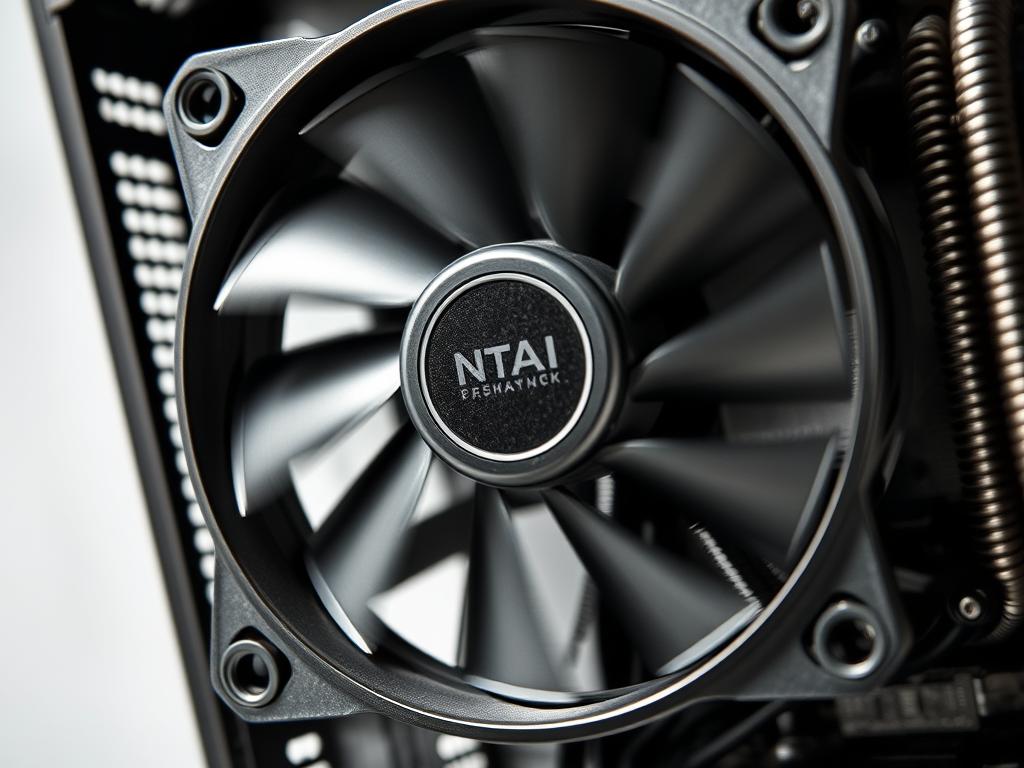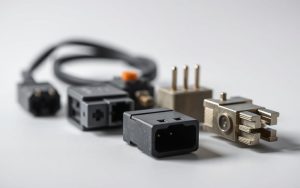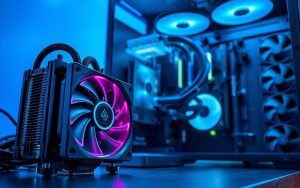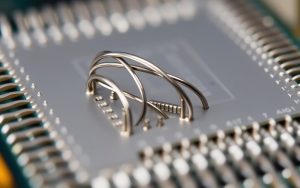Table of Contents
Computer cooling is vital for top performance and hardware protection. Most PCs have two key fans: one for the CPU and another for the GPU. Knowing how to boost fan speed can greatly improve your computer’s cooling.
Modern motherboards use pulse-width modulation (PWM) controllers for precise fan speed control. Boosting cooling helps prevent overheating and protects hardware from heat damage.
Fan speed management uses various techniques, from BIOS tweaks to third-party software. Learning to control your PC’s fan speed can boost system performance and reliability.
Let’s explore effective methods to increase PC fan speed. We’ll provide practical tips on cooling strategies for your computer system.
Understanding PC Fan Speed Control Basics
Cooling is vital for any computer system. It manages temperature through fan speed control. Modern computers use complex cooling systems to prevent overheating and maintain top performance.
Effective fan speed control requires knowledge of cooling components. Most PC cases have pre-installed fans. These are typically 120mm or 140mm in size.
These fans work together to regulate the system’s temperature. They help manage internal heat efficiently.
Types of Fan Control Methods
Two main methods exist for fan speed control:
- Voltage Regulation: Adjusts fan speed by changing the electrical supply voltage
- PWM (Pulse Width Modulation) Signals: Provides precise digital control of fan speed
How Temperature Affects Fan Operation
Temperature greatly impacts fan operation and system performance. As components heat up, fans adjust their speed automatically. Most systems aim to keep internal temperatures between 25°C to 30°C.
Common Fan Locations in Your PC
Fans are placed strategically for comprehensive cooling:
- CPU fan
- Case exhaust fans
- GPU fans
- Power supply fans
A balanced fan setup creates efficient airflow. This prevents heat buildup and protects sensitive computer parts. Experts recommend this approach for optimal cooling.
Why Controlling Fan Speed is Important

Fan speed control is vital for optimising PC performance. It keeps your computer cool and prevents hardware damage. Advanced fan control techniques can boost your system’s efficiency significantly.
Fan control affects more than just temperature. It impacts three key areas of computer performance:
- System Longevity: Proper fan management reduces stress on internal components
- Performance Stability: Consistent cooling prevents thermal throttling
- Noise Reduction: Intelligent fan speed control minimises unnecessary noise
Different tasks need unique fan speed settings. Web browsing requires minimal cooling. Gaming or video editing demand higher fan speeds.
Most modern computers use fan curves. These adjust speed based on temperature, ensuring precise thermal management.
Optimal fan control balances cooling efficiency with noise levels, creating a harmonious computing environment.
Smart fan speed strategies blend performance, longevity, and quiet operation. Understanding your system’s cooling is key to maximising your computer’s potential.
How to Increase PC Fan Speed Through BIOS
Your computer’s cooling system is vital for top performance and longevity. BIOS fan control lets you fine-tune thermal management with precision. This feature ensures your PC runs smoothly and efficiently.
Accessing BIOS Settings
To enter your computer’s BIOS, you’ll need to press a specific key during startup. Different systems use various methods. Check your motherboard manual for the exact key to use.
- Press Delete (DEL) key during boot
- Press F2 at startup screen
- Consult motherboard manual for exact key
Adjusting Fan Curves
Fan curves let you customise fan speed based on system temperature. You can typically adjust fan speed from 30% to 100%. Create custom profiles to balance performance and noise levels.
| Temperature Range | Recommended Fan Speed | Performance Impact |
|---|---|---|
| 30-50°C | 30-40% | Silent Mode |
| 50-70°C | 50-70% | Standard Performance |
| 70-85°C | 80-100% | High Performance |
Testing and Monitoring
After adjusting fan curves, keep a close eye on fan speed and system temperatures. Use BIOS monitoring tools or software like SpeedFan to track performance. Try to keep CPU temperatures below 70°C for the best system health.
- Verify fan speed changes
- Check temperature stability
- Listen for unusual noise levels
Pro tip: Make gradual adjustments to prevent system instability when setting new fan controls. This approach ensures a smooth transition to your optimised cooling setup.
Using Third-Party Software for Fan Control
Fan control software is crucial for PC enthusiasts aiming for peak system performance. SpeedFan is a versatile tool that tracks voltage, fan speed, and temperature across computer components. It supports various Windows systems, offering detailed insights into system health.
Argus Monitor is another option for managing fan speeds. It supports PWM-controlled fans and offers customisable alerts for ideal system temperatures. The full version provides comprehensive hardware monitoring, with pricing from £13.95 for one year to £29.95 for three years.
Advanced fan control software can boost system stability by reducing heat and improving efficiency. Users can create custom RPM profiles to balance cooling performance with noise reduction. This is especially useful for those wanting a quieter computing environment.
Key features often include real-time temperature monitoring and automatic fan speed adjustments. These help prevent potential overheating risks and maintain optimal system conditions.
When choosing fan control software, ensure it’s compatible with your hardware setup. Some tools like SpeedFan work with many motherboards and sensors. However, newer hardware may pose challenges for some applications.
Start with low RPM settings and adjust based on your specific needs. This approach helps find the right balance between cooling performance and system noise.
FAQ
What is PC fan speed control?
PC fan speed control manages computer cooling fan speeds. It optimises system temperature, performance, and noise levels. This method adjusts fan speeds based on internal component temperatures.
Why is fan speed control important?
Fan speed control prevents overheating and extends hardware lifespan. It maintains optimal system performance and protects components from thermal damage. Users can balance cooling efficiency with noise reduction.
What are the main methods of controlling PC fan speed?
There are two primary methods: BIOS-based control and third-party software solutions. BIOS settings allow direct hardware-level fan speed adjustments. Software tools like SpeedFan offer more flexible options for managing fan performance.
How do I know if my PC fans need speed adjustment?
Signs include excessive noise, high temperatures, and reduced system performance. Frequent thermal throttling may also indicate the need for adjustment. Use software tools to monitor internal temperatures.
Can changing fan speed damage my computer?
Careful fan speed changes won’t damage your computer. Make gradual adjustments and monitor system temperatures. Ensure fans maintain sufficient cooling for your computer’s components.
What is a fan curve?
A fan curve shows how fan speed changes with temperature. It defines the relationship between system temperatures and fan speeds. Users can create custom cooling profiles to balance performance and noise.
Which software is best for fan speed control?
Popular options include SpeedFan, Argus Monitor, and manufacturer-specific tools like MSI Afterburner. The best choice depends on your hardware and desired customisation. Download software from reputable sources and check compatibility.
How often should I adjust my PC fan speeds?
Regular monitoring is recommended, especially after hardware upgrades or environmental changes. Seasonal temperature variations may require periodic adjustments. Check when you notice performance issues.
Are software or BIOS fan controls better?
Both methods have advantages. BIOS controls offer direct hardware-level management. Software solutions provide more flexible, real-time adjustments. Choose based on your technical comfort and system requirements.
Can I manually control individual component fans?
Yes, advanced BIOS settings allow control of specific component fans. Sophisticated software enables independent speed profiles for CPU, GPU, and case fans. This approach allows precise thermal management for your computer’s needs.









